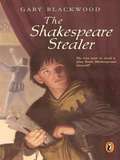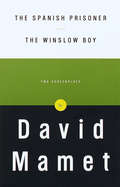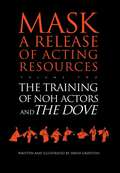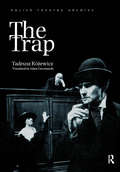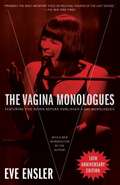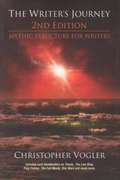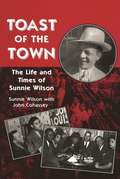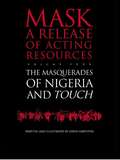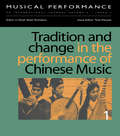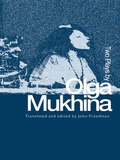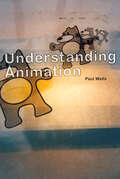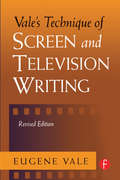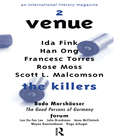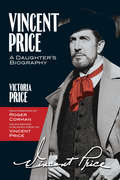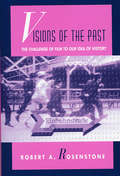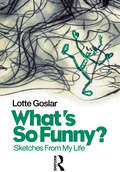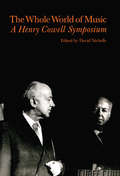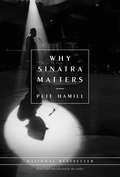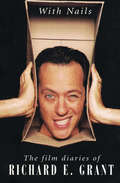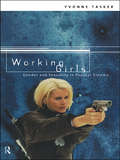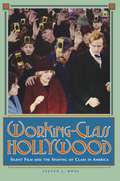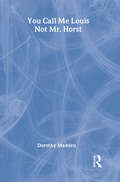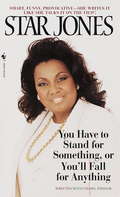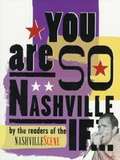- Table View
- List View
The Shakespeare Stealer
by Gary BlackwoodWidge is an orphan with a rare talent for shorthand. His fearsome master has just one demand: steal Shakespeare's play "Hamlet"--or else. Widge has no choice but to follow orders, so he works his way into the heart of the Globe Theatre, where Shakespeare's players perform. As full of twists and turns as a London alleyway, this entertaining novel is rich in period details, colorful characters, villainy, and drama."A fast-moving historical novel that introduces an important era with casual familiarity." --School Library Journal, starred review
The Spanish Prisoner and The Winslow Boy: Two Screenplays
by David MametTHE SPANISH PRISONER "Elegant, entertaining. . . . Mamet's craftiest and most satisfying cinematic puzzle. " --The New York Times THE WINSLOW BOY "One of the most subtly compelling love stories of the year. " --The New York Observer Pulitzer Prize winner David Mamet ranks among the century's most influential writers for stage and screen. His dialogue--abrasive, rhythmic--illuminates a modern aesthetic evocative of Samuel Beckett. His plots--surprising, comic, topical--have evoked comparisons to masters from Alfred Hitchcock to Arthur Miller. Here are two screenplays demonstrating the astounding range of Mamet's talents. The Spanish Prisoner, a neo-noir thriller about a research-and-development cog hoodwinked out of his own brilliant discovery, demonstrates Mamet's incomparable use of character in a dizzying tale of twists and mistaken identity. The Winslow Boy, Mamet's revisitation of Terence Rattigan's classic 1946 play, tells of a thirteen-year-old boy accused of stealing a five-shilling postal order and the tug of war for truth that ensues between his middle-class family and the Royal Navy. Crackling with wit, intelligent and surprising,The Spanish PrisonerandThe Winslow Boycelebrate Mamet's unique genius and our eternal fascination with the extraordinary predicaments of the common man.
The Training of Noh Actors and The Dove (Mask - A Release Of Acting Resources Ser. #Vol. 2)
by David GriffithsFirst Published in 1998. Routledge is an imprint of Taylor & Francis, an informa company.
The Trap
by Tadeusz RosewiczFirst Published in 1998. Routledge is an imprint of Taylor & Francis, an informa company.
The Vagina Monologues (10th Anniversary Edition)
by Eve Ensler"I was worried about vaginas. I was worried about what we think about vaginas, and even more worried that we don't think about them... So I decided to talk to women about their vaginas, to do vagina interviews, which became vagina monologues. I talked with over two hundred women. I talked to old women, young women, married women, single women, lesbians, college professors, actors, corporate professionals, sex workers, African American women, Hispanic women, Asian American women, Native American women, Caucasian women, Jewish women. At first women were reluctant to talk. They were a little shy. But once they got going, you couldn't stop them." So begins Eve Ensler's hilarious, eye-opening tour into the last frontier, the forbidden zone at the heart of every woman. Adapted from the award-winning one-woman show that's rocked audiences around the world, this groundbreaking book gives voice to a chorus of lusty, outrageous, poignant, and thoroughly human stories, transforming the question mark hovering over the female anatomy into a permanent victory sign. With laughter and compassion, Ensler transports her audiences to a world we've never dared to know, guaranteeing that no one who reads The Vagina Monologues will ever look at a woman's body the same way again.
The Writer's Journey, Second Edition: Mythic Structure for Writers
by Christopher VoglerThe Writer's Journey sets forth archetypes common in what Vogler calls "the hero's journey," the mythic structure that he claims all stories follow. In the book's first section, he lists the different kinds of typological characters who appear in stories. In the second, he discusses the stages of the journey through which the hero generally passes. The final, supplementary portion of the book explains in detail how films like Titanic and The Full Monty follow the patterns he has outlined.
Toast of the Town: The Life and Times of Sunnie Wilson (Great Lakes Books Series)
by Sunnie Wilson John CohasseyTouch and the Masquerades of Nigeria (Mask - A Release Of Acting Resources Ser. #Vol. 4)
by David Griffiths D. GriffithsFirst published in 1997. Routledge is an imprint of Taylor & Francis, an informa company.
Tradition & Change Performance (Musical Performance Ser. #Vols. 2, Pts. 2.)
by TsaoFirst published in 1998. Routledge is an imprint of Taylor & Francis, an informa company.
Two Plays by Olga Mukhina (Russian Theatre Archive Ser. #Vol. 18)
by John FreedmanOlga Mukhina is one of the most talented, young playwrights in Russia. Born in Moscow in 1970, she has already garnered enviable praise from critics and audiences throughout Russia and Europe since her first play, Tanya-Tanya, was performed in 1996. Tanya-Tanya is an atmospheric, poetic tale that observes three couples at a suburban Moscow home who dance, drink champagne, kiss, fall in and out of love, and struggle with dignity and humor to keep some semblance of control over their lives. The parallels with Chekhovian drama are undeniable and clearly intended by the author. You, Mukhina's most recent work, is a love poem to her hometown of Moscow as well as a scathing attack on the apathy of people blindly wrapped up in their own happiness and sorrow.
Understanding Animation
by Paul WellsFirst Published in 1998. Routledge is an imprint of Taylor & Francis, an informa company.
Vale's Technique of Screen and Television Writing
by Eugene ValeVale's Technique of Screen and Television Writing is an updated and expanded edition of a valuable guide to writing for film and television. Mr. Vale takes the aspiring writer through every phase of a film's development, from the original concept to the final shooting script. Teachers of the craft as well as writers and directors have acclaimed it as one of the best books ever written on how to write a screenplay. This book combines practical advice for the aspiring or established writer with a lucid overview of the unique features of this most contemporary art form, distinguishing film and video from other media and other kinds of storytelling. It teaches the reader to think in terms of the camera and gives practical advice on the realities of filmmaking. At the same time, Vale, who began his own career as a scriptwriter for the great French director Jean Renoir, provides a solid grounding in the history of drama from the Classical Greek theater through the great cinematic works of the twentieth century. Both philosophical and pragmatic, this is a very readable book for students and active professionals who want to improve their writing skills, and for film enthusiasts interested in knowing more about what they see on the screen.Mr. Vale is that rare combination, a practitioner of great experience who can offer a lucid explanation of his craft.Eugene Vale was born in Switzerland and began his career in France in the 1930s. He was an award-winning novelist, film and TV scriptwriter and teacher, whose works include the bestselling novel The Thirteenth Apostle and the scripts for Francis of Assisi, The Bridge of San Luis Rey, and The Second Face. He also worked in many other areas of the motion picture industry, including directing, producing, cutting, distribution and finance. His archives are held by Boston University and University of Southern California. Mr. Vale died in 1997, shortly after he completed the updated version of this handbook.
Venue 2
by BrenkmanFirst Published in 1998. Routledge is an imprint of Taylor & Francis, an informa company.
Vincent Price: A Daughter's Biography
by Victoria Price Roger CormanSince his death in 1993, Vincent Price’s legacy as a Hollywood legend has only grown in stature. His lengthy and distinguished career—as the voice of The Saint on the radio; as an actor in such unforgettable horror films as House of Wax and The Fly, in classic movies such as Laura and The Song of Bernadette, and on popular TV shows such as Batman and The Brady Bunch; and as a star on the Broadway stage—spanned sixty-five years. In addition to being an icon of stage and screen, Price was an art historian and collector who did much to popularize the visual arts in the United States, as well as a gourmet chef and author of bestselling cookbooks. Widely revered for his elegance and erudition, this Renaissance man left his mark on many areas of American culture during the twentieth century. <P><P> Vincent Price was also a loving father to his daughter Victoria, who was born shortly before he turned fifty-one, at the height of his popularity. Though the star’s busy film schedule took him in and out of his young daughter’s life, he was always a larger-than-life presence and, simply, her father. The deep bond between father and daughter managed to survive the machinations of Price’s third wife, the elegant British actress Coral Browne, who resented the close relationship between Price and his children and grandchildren. After Browne’s death, Price and his daughter spent over a year taping conversations that would form the basis of this compelling biography-cum-memoir. <P><P> In writing about the father she adored, Victoria Price reveals a man complex, human, and humorous. An actor of range, less than one-third of the movies in which he appeared were in the horror genre. As a pre-war anti-Nazi sympathizer, he was greylisted during the Red Scare of the 1950s until, in a desperate gesture, he signed a secret oath that saved his career. His passion for the arts gave him a second life as a savvy columnist and museum founder, even as his films were featured in drive-ins nationwide. And through it all, Vincent Price’s professionalism, grace under pressure, and tongue-in-cheek humor earned him lifelong friendships among his peers and generation after generation of loyal fans. <P><P> Victoria Price’s account of her father is one of candor and honesty; both his passionate and charismatic public persona and his conflicted inner life are treated with curiosity and understanding. Vincent Price: A Daughter’s Biography is, in short, the thorough—and uniquely intimate—life of a legend.
Visions of the Past: The Challenge of Film to Our Idea of History
by Robert A. RosenstoneCan filmed history measure up to written history? What happens to history when it is recorded in images, rather than words? Can images convey ideas and information that lie beyond words? Taking on these timely questions, Robert Rosenstone pioneers a new direction in the relationship between history and film. Rosenstone moves beyond traditional approaches, which examine the history of film as art and industry, or view films as texts reflecting their specific cultural contexts. This essay collection makes a radical venture into the investigation of a new concern: how a visual medium, subject to the conventions of drama and fiction, might be used as a serious vehicle for thinking about our relationship with the past. Rosenstone looks at history films in a way that forces us to reconceptualize what we mean by "history." He explores the innovative strategies of films made in Africa, Latin America, Germany, and other parts of the world. He journeys into the history of film in a wide range of cultures, and expertly traces the contours of the postmodern historical film. In essays on specific films, including Reds, JFK, and Sans Soleil, he considers such issues as the relationship between fact and film and the documentary as visionary truth. Theorists have for some time been calling our attention to the epistemological and literary limitations of traditional history. The first sustained defense of film as a way of thinking historically, this book takes us beyond those limitations.
What's So Funny?: Sketches from My Life (Choreography and Dance Studies Series #Vol. 15)
by Lotte GoslarFirst Published in 1998. Routledge is an imprint of Taylor & Francis, an informa company.
Whole World of Music: A Henry Cowell Symposium (Contemporary Music Studies)
by David NichollsFirst Published in 1998. Routledge is an imprint of Taylor & Francis, an informa company.
Why Sinatra Matters
by Pete HamillIn this unique homage to an American icon, journalist and award-winning author Pete Hamill evokes the essence of Sinatra--examining his art and his legend from the inside, as only a friend of many years could do. Shaped by Prohibition, the Depression, and war, Francis Albert Sinatra became the troubadour of urban loneliness. With his songs, he enabled millions of others to tell their own stories, providing an entire generation with a sense of tradition and pride belonging distinctly to them.
With Nails: The Film Diaries of Richard E. Grant
by Richard E. GrantThe star of the cult classic Withnail and I offers &“a refreshing combination of comedy, confession, and coruscation&” in this memoir of the movie business (Kirkus Reviews). Richard E. Grant&’s acting career has included memorable roles in some of Hollywood&’s most critically acclaimed films, including Robert Altman&’s Gosford Park and Francis Ford Coppola&’s Dracula. But he attributes his success to his first film role, starring as a flamboyantly pathetic Shakespearean in the underground hit Withnail and I. As Grant explains, &“I had no notion that, almost without exception, every film offered since would be the result of playing an alcoholic out-of-work actor.&” In With Nails, Grant shares his long, maddening, and immensely rewarding journey through the world of film. From the hell of making Hudson Hawk to befriending Steve Martin on the set of L.A. Story; and from eating spaghetti with the Coppolas, to window-shopping with Sharon Stone, and working with and learning from the best actors and directors in the business, Grant&’s unvarnished memoir &“is a biting and wonderfully funny look at the movie business by an actor who is as clear-eyed and observant about himself as he is about the craziness surrounding him&” (Publishers Weekly, starred review).
Working Girls: Gender and Sexuality in Popular Cinema
by Yvonne TaskerWorking Girls investigates the thematic concerns of contemporary Hollywood cinema, and its ambivalent articulation of women as both active, and defined by sexual performance, asking whether new Hollywood cinema has responded to feminism and contemporary sexual identities. Whether analysing the rise of films centred around female friendships, or the entrance of pop stars such as Whitney Houston and Madonna into film, Working Girls is an authoritative investigation of the presence of women both as film makers and actors in contemporary mainstream cinema.
Working-Class Hollywood: Silent Film and the Shaping of Class in America
by Steven J. RossThis path-breaking book reveals how Hollywood became "Hollywood" and what that meant for the politics of America and American film. Working-Class Hollywood tells the story of filmmaking in the first three decades of the twentieth century, a time when going to the movies could transform lives and when the cinema was a battleground for control of American consciousness. Steven Ross documents the rise of a working-class film movement that challenged the dominant political ideas of the day. Between 1907 and 1930, worker filmmakers repeatedly clashed with censors, movie industry leaders, and federal agencies over the kinds of images and subjects audiences would be allowed to see. The outcome of these battles was critical to our own times, for the victors got to shape the meaning of class in twentieth- century America. Surveying several hundred movies made by or about working men and women, Ross shows how filmmakers were far more concerned with class conflict during the silent era than at any subsequent time. Directors like Charlie Chaplin, D. W. Griffith, and William de Mille made movies that defended working people and chastised their enemies. Worker filmmakers went a step further and produced movies from A Martyr to His Cause (1911) to The Gastonia Textile Strike (1929) that depicted a unified working class using strikes, unions, and socialism to transform a nation. J. Edgar Hoover considered these class-conscious productions so dangerous that he assigned secret agents to spy on worker filmmakers. Liberal and radical films declined in the 1920s as an emerging Hollywood studio system, pressured by censors and Wall Street investors, pushed American film in increasingly conservative directions. Appealing to people's dreams of luxury and upward mobility, studios produced lavish fantasy films that shifted popular attention away from the problems of the workplace and toward the pleasures of the new consumer society. While worker filmmakers were trying to heighten class consciousness, Hollywood producers were suggesting that class no longer mattered. Working-Class Hollywood shows how silent films helped shape the modern belief that we are a classless nation.
World's Dumbest Crooks and Other True Tales of Bloopers, Botches & Blunders
by Allan ZulloLife's Hall of Shame is a mythical place where people are (dis)honored for bungling big time -- so big it's worthy of special attention. That's what this book is about. It's a lighthearted look at some of the wackiest, silliest, wildest blunders that have ever happened.
You Call Me Louis, Not Mr. Horst
by Dorothy MaddenDorothy Madden's lively book about Louis Horst (You don't call me Mr. Horst, you call me Louis, he always said) makes for compulsive reading. She follows Horst's extraordinary life, punctuating her narrative with reminiscences, illuminating anecdotes from her personal store of memories, as well as the shared thoughts of others, all interspersed with her choice of evocative and expressive photographs and illustrations, to create a dynamic and memorable portrait of this key figure in American modern dance. Louis Horst: musician, composer, pianist, violonist, pit player, arranger, super accompanist (all sorts), conductor, régisseur, stage manager, tour tartar, catalyst, editor, writer, critic, teacher, consoler, the Sherlock Holmes of restaurants, keeper of journals and budgets, loan provider, lover, friend...
You Have to Stand for Something, Or You'll Fall for Anything
by Star JonesSmart, funny, provocative--she writes it like she talks it on The View!Strongly held beliefs, a wicked sense of humor, and take-no-prisoners opinions--her many fans have come to expect all this and more from Star Jones, co-host of ABC-TV's hit show The View.In this remarkable book, the former New York City prosecutor shows why she has become one of the most quoted and respected media personalities of our time. Here she touches fearlessly on subjects both conventional and controversial, such as the importance of family and friendship, the law, racism, abortion, television, politics, and her relationship with God. And she does it all with a unique and refreshing viewpoint that will make you think twice about everything you thought you knew.Here, too, is her powerful and intensely personal story, told with warmth, humor, and sometimes painful candor. This is an empowering memoir by a remarkable woman who not only walks the walk and talks the talk but challenges you to do the same.
You are So Nashville If...
by Bruce DobieSpanning nine years, "You Are So Nashville If . . ". offers a rollicking, sometimes touching, sometimes bizarre look at the people, places, and things that make Nashville what it is. Includes more than 700 entries.
